The Carolina Parakeet, also known as Conuropsis carolinensis, was a colourful bird native to the eastern part of the United States. Sadly, it is now extinct, making it a fascinating subject for our blog. This article will explore the history, facts, size, habitat, and classification of the Carolina Parakeet.
The Carolina Parakeet was vibrant, with a green body, yellow head, and red and yellow feathers around the face. They were social birds, often seen in large flocks flying through the skies. This species primarily fed on fruits, seeds, and nuts, and their beaks were well adapted for cracking open tough shells.
Sadly, due to human activities such as hunting and habitat destruction, the Carolina Parakeet became extinct in 1918. These beautiful birds once thrived in habitats such as forests, swamps, and grasslands across the eastern states. Understanding their history and characteristics can help us appreciate the importance of conservation efforts for other endangered animals.
Studying and learning about extinct species like the Carolina Parakeet is essential to prevent the loss of other animals in the future. Our blog aims to create awareness about various animal species, including the Carolina Parakeet, and promote the importance of protecting wildlife and their habitats. Stay tuned for more exciting articles, as we already have an extensive collection featuring over 155+ animal names.
History of Carolina Parakeet
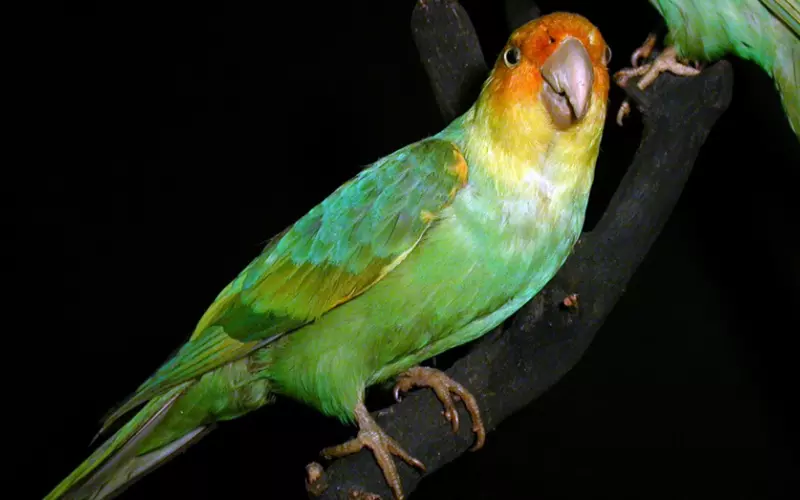
The Carolina Parakeet was a special bird that once lived in North America, particularly in the eastern parts of the United States. They were very colourful with bright green feathers, yellow heads, and beautiful red-orange faces. The Carolina Parakeet liked to eat fruits, seeds, and even flowers. They were very social birds and lived together in large flocks, so they liked hanging out with their friends and family.
Sadly, the Carolina Parakeet is no longer with us today. The last known Carolina Parakeet died in captivity in 1918. But before that, these birds used to fly freely across the sky and could be found in many different states. They had a unique ability to adapt to different habitats, from thick forests to open fields. However, because people wanted to use their feathers to make fashionable hats and because they were hunted for their meat and captured as pets, their population started to decline rapidly.
The extinction of the Carolina Parakeet is a sad part of our history. It reminds us of the importance of protecting and preserving the natural world around us. Today, laws and organisations work to conserve and protect endangered animals so they don’t disappear forever. While the Carolina Parakeet may no longer fly in our skies, we can still honour its memory by learning from its story and becoming better guardians of our planet.
Importance of Carolina Parakeet
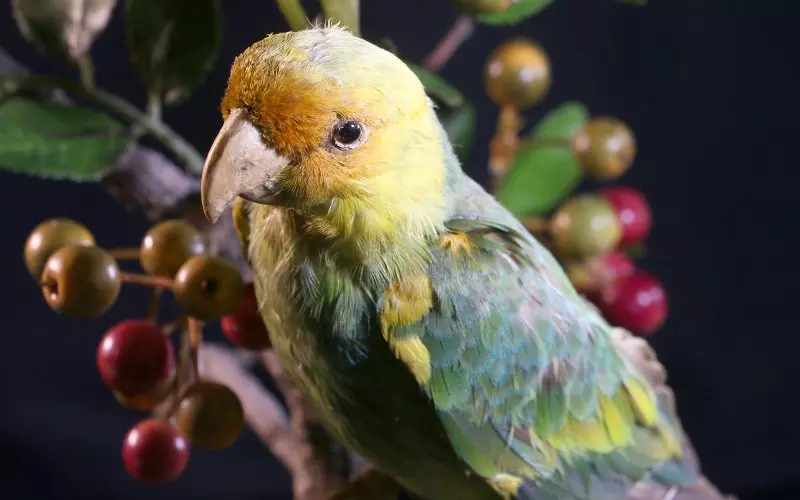
The Carolina Parakeet bird was vital because it played a crucial role in maintaining the balance of nature. It had a particular job to do: disperse the seeds of various plants and trees in the wild. When the Carolina Parakeet ate fruits, it swallowed the seeds as well. Later, when the bird pooped or dropped its waste, the seeds would come out with it and fall to the ground, creating new plants and trees. This process of seed dispersal through the Carolina Parakeet was essential in helping the forests and ecosystems thrive.
Another critical aspect of the Carolina Parakeet was its vibrant and striking appearance. Its beautiful green feathers, yellow head, and bright red cheeks made it a fascinating bird. Its unique colours amaze people, making it a beloved bird for many. The presence of Carolina Parakeets in the wild added beauty and diversity to the environment.
Lastly, the Carolina Parakeet had cultural significance for indigenous people and early settlers in its range. The parakeet was a part of their folklore, art, and daily life. Native Americans used its feathers for decorative purposes and as a lightweight material for making clothes, headpieces, and accessories. The Carolina Parakeet held cultural value and was deeply connected to the history and traditions of the people who lived alongside them.
To sum up, the Carolina Parakeet played a vital role in maintaining the ecosystem balance through seed dispersal, adding beauty to the environment with its colourful appearance, and having cultural significance for the people who shared its habitat. Its presence was not only crucial for the natural world but also for the cultural heritage of humans. Unfortunately, the extinction of the Carolina Parakeet in the early 20th century has left a void in our environment, reminding us of the importance of conservation and protecting other species from meeting the same fate.
Amazing Facts About Carolina Parakeet
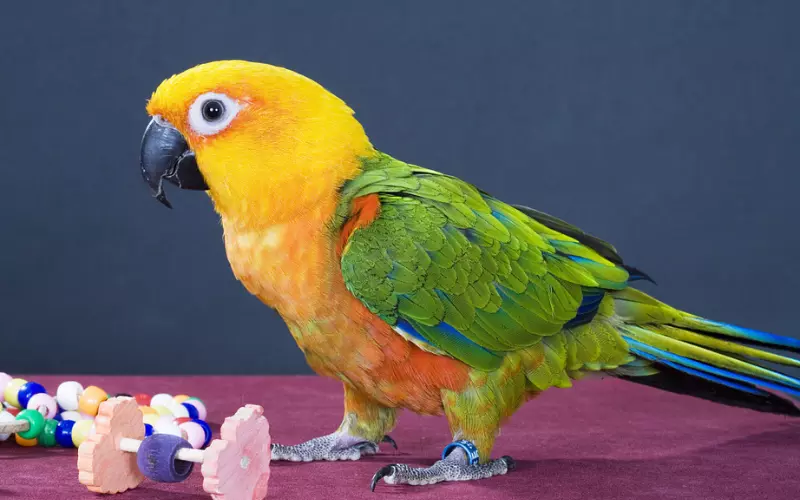
1. The Carolina Parakeet bird was a parrot species native to the southeastern United States, including states such as Florida, Georgia, and the Carolinas.
2. It was the only species of parrot native to the eastern United States and was known for its vibrant plumage, which consisted of green feathers, a yellow head, and a bright red-orange face.
3. Carolina Parakeets were social birds that lived in flocks and were often seen flying and feeding together in groups.
4. They were about 13 inches long, making them relatively small parrots compared to other species.
5. Carolina Parakeets had a unique ability to eat toxic seeds, such as those from the cocklebur or the poisonous dogwood tree, without adverse effects on their health.
6. Their diet also included various fruits, berries, and nuts found in their natural habitat.
7. These parakeets were highly adaptable and could thrive in different habitats, including temperate forests, swampy areas, and even agricultural lands.
8. They possessed strong beaks, which allowed them to crack open hard seeds and rip into fruits to extract nutrients.
9. Carolina Parakeets were monogamous birds, forming long-term pair bonds with a single mate for life.
10. While they were known for being loud and noisy birds, they used their calls to communicate with each other within the flock.
11. Despite their bright colours, Carolina Parakeets were good at camouflaging themselves in the treetops due to their green feathers, making them difficult to spot by predators.
12. Sadly, the population of Carolina Parakeets declined rapidly during the late 1800s due to habitat loss, hunting for their feathers, and the capture of live birds for the pet trade.
13. The last known wild individual was observed in Florida in 1904, and the species was declared extinct in 1939.
14. Some Carolina Parakeets were kept as pets, but they were challenging to breed in captivity, contributing to their decline.
15. Efforts to protect and conserve the Carolina Parakeet were limited; sadly, this charismatic bird became a tragic example of the devastating consequences of human activities on wildlife populations.
Can we keep Carolina Parakeet as our Pet?

The Carolina Parakeet bird, unfortunately, cannot be kept as a pet. This is because the Carolina Parakeet is extinct, which means that it no longer exists in the world today. It is essential to understand that extinct animals cannot be found anywhere anymore, so having them as pets is impossible.
The extinction of the Carolina Parakeet is indeed a sad story. These beautiful birds were once abundant in North America, with vibrant green feathers and a bright yellow head. However, their numbers started declining due to habitat loss, hunting, and diseases. Humans hunted many Carolina Parakeets for their colourful feathers, used in fashion then. Also, the loss of their natural habitat and the introduction of new predators contributed to their decline. Eventually, in 1918, the last Carolina Parakeet named “Incas” passed away in captivity, marking the end of their species.
While it is unfortunate that we cannot keep Carolina Parakeets as pets, their extinction should serve as a lesson. We must understand the importance of preserving and protecting the environment and wildlife. It is crucial to conserve the habitats of different species and not contribute to their extinction. By learning from the past, we can ensure that no more beautiful creatures like the Carolina Parakeet face a similar fate.
Size of Carolina Parakeet

The Carolina Parakeet bird was about the same size as a small parrot. It measured around 13 inches from its beak to the tip of its tail. Its body was mainly green with a yellow head and bright orange feathers on its face and neck. This beautiful bird had long, slender wings and a short, hooked beak.
Sadly, the Carolina Parakeet bird is now extinct. It used to be found in various parts of the United States, including the Southeast and Midwest regions. They lived in forests, swamps, and woodlands, where they could find plenty of food, such as berries, fruits, and nuts.
The Carolina Parakeet bird was a social creature, often seen in large flocks. These flocks could contain hundreds or thousands of birds, making an impressive sight as they flew together. They were known to be noisy, with loud calls and squawks filling the air.
The Carolina Parakeet bird was a beautiful and vibrant species, about the size of a small parrot. This unique bird had a green body with an orange face and neck. Unfortunately, they are now extinct, but they used to live in forests and woodlands, where they formed large flocks.
Habitat of Carolina Parakeet
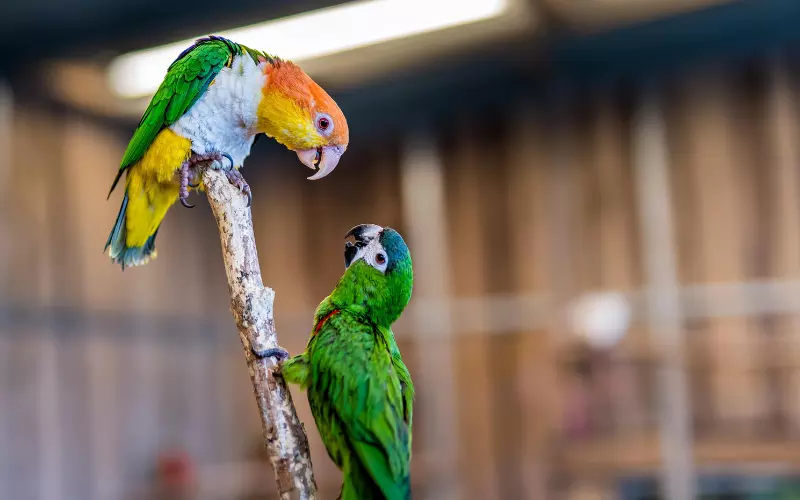
The Carolina Parakeet was once a common and vibrant bird in the United States. These lovely birds had a unique habitat and lived in various places. They preferred to make their homes in forests and woodlands, especially the ones near rivers and swamps. The abundance of trees and water availability made these areas perfect for the Carolina Parakeet to build nests and find food.
In their natural habitat, Carolina Parakeets loved to feed on tree seeds, berries, fruits, and nuts. They particularly enjoyed munching on the seeds of cypress trees. Being skilled climbers, they would also search for insects and their larvae in tree bark. The colour of their feathers blended perfectly with the surrounding leaves, camouflaging them from predators and helping them move around without being noticed.
Carolina Parakeets often flew together in large flocks, sometimes with hundreds of fellow parakeets. They were highly social birds, and by sticking together, they could protect themselves from predators such as hawks and eagles. Their loud and unique calls would echo through the forests as they communicated with each other and warned of potential danger.
Sadly, due to deforestation and hunting by humans, the Carolina Parakeet is now extinct. We need to learn from their story so we understand the importance of protecting the habitats of birds and animals. Every creature has a role to play in maintaining a healthy ecosystem, and by preserving their habitats, we can ensure the survival of many beautiful species like the Carolina Parakeet for future generations to appreciate.
Evolution of Carolina Parakeet
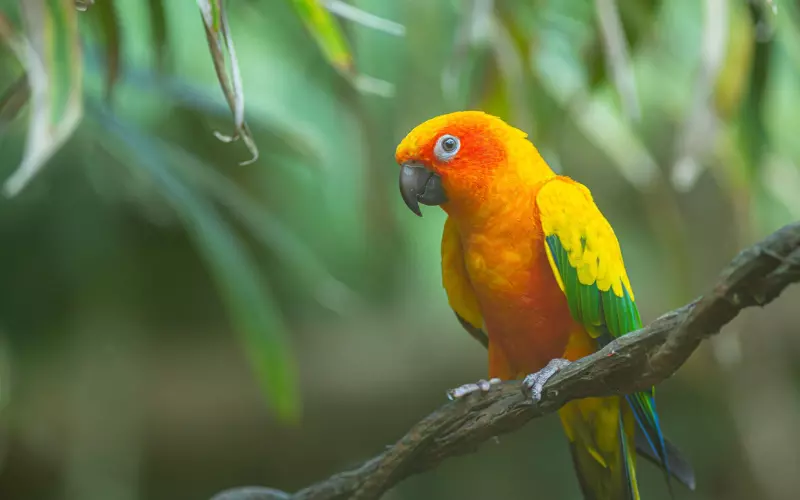
The Carolina Parakeet bird went through many changes over time. Long ago, these colourful birds lived in many places across America. They had bright green feathers and a lovely yellow head. They were friendly and loved to fly in large flocks, making beautiful sights in the sky.
But as time passed, things started to change for the Carolina Parakeet. Settlers arrived in America and started to cut down forests to build towns and cities. This made it harder for the parakeets to find food and places to live. Additionally, people hunted these birds for their colourful feathers, used to make fancy hats and accessories. Sadly, their numbers began to decline.
Another reason why the Carolina Parakeet became extinct was because of diseases. Back in those days, there were no medicines to help sick birds. When one parakeet in a flock got sick, it could quickly spread to others, wiping out entire groups. This made it even harder for the Carolina Parakeets to survive.
Sadly, the last Carolina Parakeet was seen in the wild in 1904. These beautiful birds couldn’t adapt to the changes humans brought to their habitats. They are now extinct, no longer flying in the sky or gracing our forests. We must remember their story as a lesson to take care of nature and protect the fantastic creatures that share our planet.
Classification of Carolina Parakeet
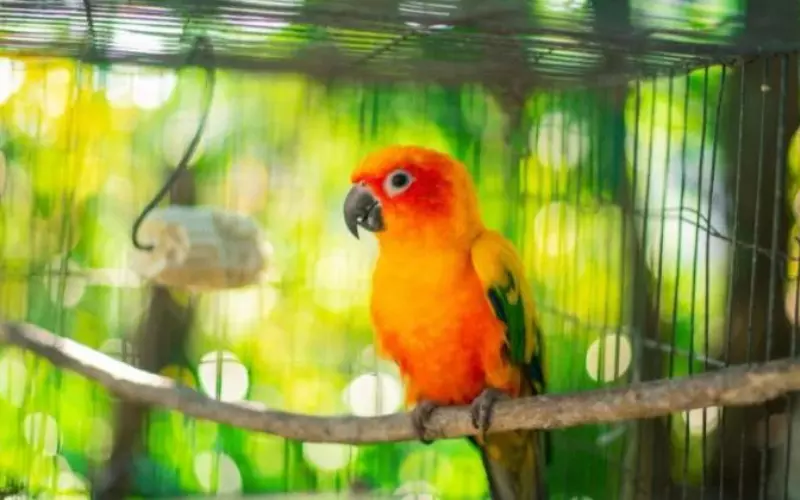
The Carolina Parakeet bird belongs to the Psittaciformes, which includes around 393 species of parrots and parakeets. It is the only species from the Conuropsis genus known by its scientific name, Conuropsis carolinensis. Sadly, this beautiful bird went extinct in the early 20th century, and now it can only be found in museums and books.
The Carolina Parakeet was a medium-sized bird, measuring about 30 centimetres. Its body was vibrant green, with a yellow head and neck. The bird had a long tail, blue wings, and a hooked beak, typical of parrots. Its unique feature was the bright orange feathers around its face, enhancing its beauty. Native to North America, it was found in states such as Florida, Louisiana, and Ohio.
Carolina Parakeets lived in forests and wooded areas and were highly social birds. They used to live in large flocks, making loud, screeching calls that could be heard from a distance. Their diet consisted mainly of fruits, seeds, and nuts. Unfortunately, due to habitat destruction, hunting for feathers, and the pet trade, the population of Carolina Parakeets declined rapidly. The last known wild Carolina Parakeet was observed in 1904, and the last bird died in captivity in 1918.
The Carolina Parakeet is a fascinating bird once abundant in North America but is now extinct. It belonged to the Psittaciformes group and had unique features such as its vibrant green body, yellow head, and orange face feathers. Although it is sad to know that this bird is no longer with us, we can still appreciate its beauty through pictures and stories from the past.
Different Types of Carolina Parakeet

1. Green Carolina Parakeet: The most common type of Carolina Parakeet is the Green Carolina Parakeet, with vibrant green feathers and a yellow face. They are known for their friendly nature and cheerful chirping sounds in the wild.
2. Blue Carolina Parakeet: This striking bird has beautiful blue feathers with hints of green on its wings. The Blue Carolina Parakeet is slightly smaller than the green variety but shares the same friendly and social characteristics.
3. Yellow Carolina Parakeet: The Yellow Carolina Parakeet is a unique type known for its bright yellow plumage. They are often seen in small groups or pairs, and their distinctive colouration helps them blend in with their surroundings in the wild.
4. Red-faced Carolina Parakeet: As the name suggests, this type of Carolina Parakeet has a red face, blending beautifully with its green feathers. They are brilliant birds with various vocalizations to communicate with their flock members.
5. Orange-winged Carolina Parakeet: Featuring a combination of green feathers and vibrant orange wings, the Orange-winged Carolina Parakeet is known for its playful behaviour and its ability to mimic various sounds. They are often found near water sources like rivers or lakes.
6. Pink Carolina Parakeet: The Pink Carolina Parakeet is a lovely variety with predominantly pink feathers and a yellowish head. They can rotate their heads almost 180 degrees, enabling them to observe their surroundings more effectively.
7. White-winged Carolina Parakeet: With its white wings in contrast to its green body, the White-winged Carolina Parakeet stands out among other types. These birds are skilled nest builders, constructing elaborate nests high up in tree cavities to ensure the safety of their offspring.
8. Purple Carolina Parakeet: The Purple Carolina Parakeet is easily recognizable due to its deep purple feathers. They have a strong curiosity, often exploring their environment and testing various objects with their beaks to learn more about their surroundings.
9. Black-headed Carolina Parakeet: This type of Carolina Parakeet has a black head and neck, whereas the rest of its body is covered in green feathers. They are known for their acrobatic flying skills and can perform impressive aerial displays during mating season.
10. Multicolored Carolina Parakeet: As the name suggests, the Multicolored Carolina Parakeet possesses a combination of various vibrant colours, such as green, blue, yellow, and red. They are friendly birds, often seen in large flocks, and are highly adaptable to various habitats, from forests to grasslands.
Geographical Presence of Carolina Parakeet

The Carolina Parakeet bird is found in the southeastern United States. This region includes states like North Carolina, South Carolina, Georgia, Florida, and parts of Alabama and Mississippi. These vibrant and beautiful birds live in various habitats, such as forests, woodlands, swamps, and agricultural areas.
However, sadly, the Carolina Parakeet is no longer found in its original habitat. Due to various reasons like hunting, deforestation, and the loss of suitable nesting sites, these birds have become extinct. The last recorded sighting of a Carolina Parakeet was in the early 1900s. Despite attempts to preserve and protect them, human activity and habitat destruction combined led to their disappearance.
Nowadays, if one wishes to see a Carolina Parakeet, one can only admire them in museums through preserved specimens or paintings and drawings from the past. It is a reminder of the negative impact that human activities can have on the natural world and the importance of conservation efforts to protect endangered species.
The Carolina Parakeet was once found in the southeastern region of the United States, including states like North Carolina, South Carolina, Georgia, Florida, and parts of Alabama and Mississippi. However, due to hunting, deforestation, and the loss of suitable nesting sites, these birds have sadly become extinct and are no longer found in their original habitat.
Scientific Name of Carolina Parakeet
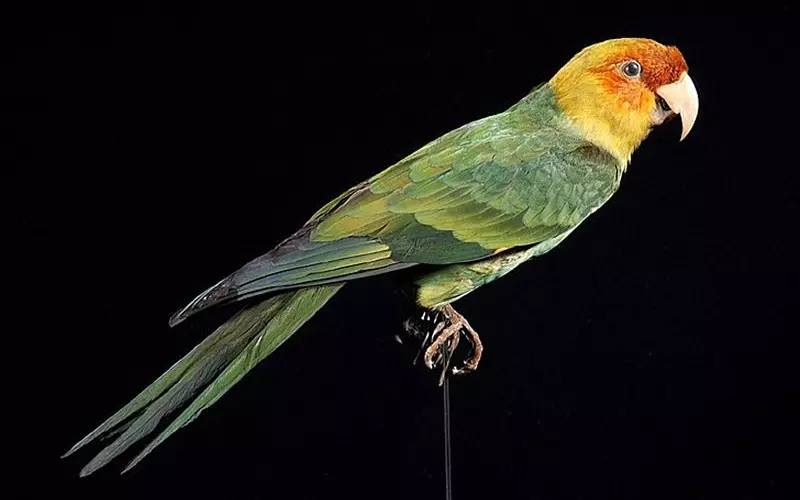
The Carolina Parakeet bird, scientifically known as Conuropsis carolinensis, is a bird species that used to inhabit parts of North America. It belonged to the parrot family and was once a common sight in the southeastern United States, including Florida, Virginia, and Louisiana. Sadly, the Carolina Parakeet is now considered extinct due to habitat destruction and hunting.
The scientific name of the Carolina Parakeet helps scientists identify and classify this particular bird species. Each species has its unique scientific name, which consists of two parts – the genus name and the species name. In this case, “Conuropsis” represents the genus, and “carolinensis” indicates the species. These names allow scientists to communicate and study specific organisms based on their characteristics and relationships with other species.
The Carolina Parakeet was a colourful bird known for its vibrant green feathers and yellow head. It used to live in forests and swamps and fed on fruits, seeds, and nuts. Unfortunately, as human activities expanded, deforestation occurred, and crops were cultivated, leading to a decline in the bird’s natural habitat. Moreover, the parakeets were hunted extensively due to their beautiful feathers and perceived threat to agriculture. Without adequate protection and conservation efforts, the Carolina Parakeet became extinct around 1918, marking a sad loss in biodiversity.
Diet of Carolina Parakeet
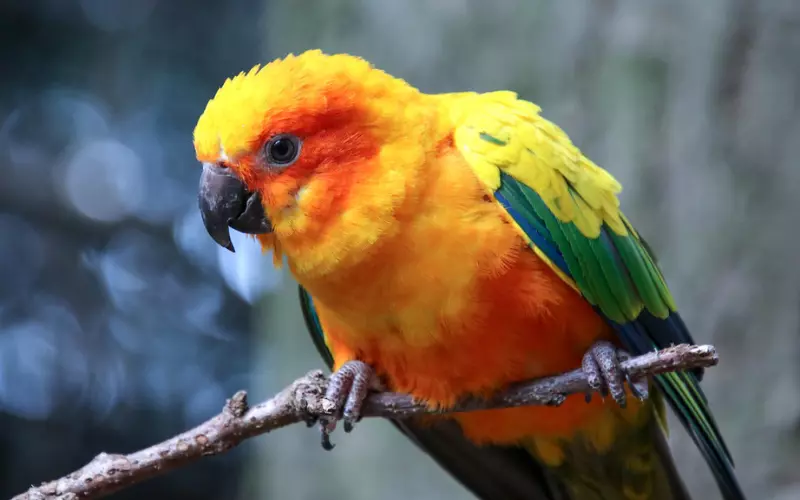
The diet of the Carolina Parakeet bird mainly consisted of fruits, seeds, and nuts. These colourful birds loved to eat the pulp of various fruits, such as apples, wild grapes, and persimmons. They also enjoyed feasting on various seeds, including sunflower and hemp seeds. The Carolina Parakeet was also fond of crunchy nuts like hickory nuts and cockleburs.
Fruits were an important part of their diet because they provided the parakeets with essential vitamins and nutrients. The birds would use their strong beaks to crack open the tough outer shells and eagerly devour the juicy insides. In the same way, they would peck at sunflowers to reach the nutritious seeds hidden inside. Nuts were a tasty treat and provided energy to sustain these active birds throughout the day.
Interestingly, the Carolina Parakeet had a unique way of obtaining food. They often gathered in large flocks and fed together, creating a lively and social feeding atmosphere. This behaviour allowed them to locate food more efficiently and protect potential predators. By eating together, they could watch out for each other and alert the group to any danger.
The diet of the Carolina Parakeet included delicious fruits, seeds, and nuts. These birds loved to feast on apples, wild grapes, persimmons, sunflower seeds, hemp seeds, hickory nuts, and cockleburs. They would gather in flocks, enjoying their meals while keeping an eye out for predators. Unfortunately, the Carolina Parakeet became extinct in the early 20th century due to various factors, including habitat loss and hunting. We can learn from their diet and help protect other endangered species to ensure survival.
Locomotion of Carolina Parakeet

The Carolina Parakeet bird moved uniquely. It had strong wings that helped it fly swiftly through the air. Flying was its primary way of getting around. It could soar high in the sky and travel long distances for food and shelter. With its vibrant green feathers and bright yellow head, it was a beautiful sight as it gracefully flapped its wings.
When the Carolina Parakeet wasn’t flying, it could also walk on branches and crawl on the ground with its tiny feet and sharp claws. It would cling tightly to branches, allowing it to perch securely. It would use its feet and claws to hop and climb on the ground, exploring the world around it. The locomotion, or movement, of the Carolina Parakeet was mainly through flying, but it could also walk and crawl with ease using its nimble feet and claws.
Social and Sexual Behaviour of Carolina Parakeet
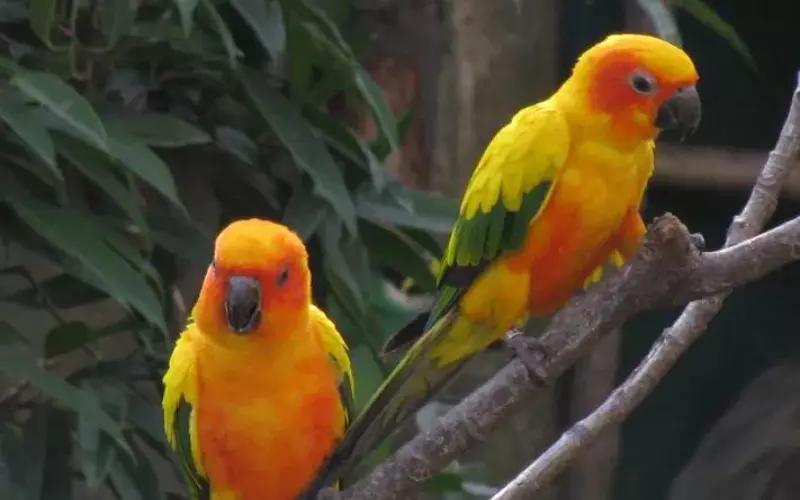
The Carolina Parakeet bird had fascinating social behaviour. They lived in flocks, which means they stayed together in large groups. This helped them find food and protect themselves from predators. The flocks were known to fly together beautifully synchronised, making unique patterns in the sky. They also communicated with one another using various calls and squawks. This helped them stay connected and know what was happening around them.
Regarding their sexual behaviour, the Carolina Parakeet birds were monogamous, forming lifelong partnerships with just one mate. They were very loyal and stayed together until one of them died. They would build nests together and lay their eggs in tree cavities. The male and female took turns incubating the eggs and feeding the chicks. They were great parents and worked as a team to raise their babies.
Sadly, the Carolina Parakeet birds became extinct due to habitat destruction and hunting. We have lost a fantastic bird species with fascinating social and sexual behaviour. We need to learn from their story and take better care of the remaining wildlife so they do not meet the same fate as the Carolina Parakeet bird.
Reproduction and Lifecycle of Carolina Parakeet

The Carolina Parakeet bird has a unique and fascinating life cycle. Like other birds, the Carolina Parakeet starts its life as an egg. The female bird lays her eggs in tree hollows. She usually lays around 1 to 5 eggs at a time. The eggs are small and white and need to be kept warm. The female parakeet takes turns with the male to incubate the eggs, keeping them warm until they hatch.
After about three weeks, the eggs hatch into baby parakeets called chicks. The chicks are born helpless and without feathers. They rely on their parents for warmth, protection, and food. The parents feed the chicks a diet of seeds, fruits, and even insects. As the chicks grow, they start developing feathers and become stronger.
The Carolina Parakeet bird reaches its adulthood at about two years old. At this stage, they are ready to find a mate and reproduce. During the mating season, male parakeets try to attract females by performing elaborate courtship displays, such as dancing and making loud calls. Once a pair has bonded, they build a nest together, and the female bird lays eggs. This fantastic life cycle continues as the new generation of Carolina Parakeets is born and grows to become adults.
Threats to Carolina Parakeet
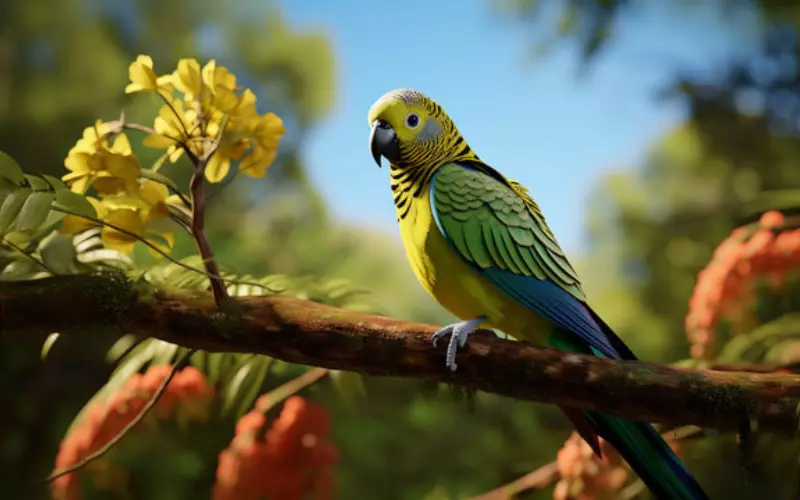
The Carolina Parakeet bird faced numerous threats in the past. One of the biggest dangers was human activities. People hunted these birds for their colourful feathers, used to make fashionable hats. The parakeets were also killed because they were seen as agricultural pests and sometimes ate farmers’ crops. Humans began to cut down the trees where these birds lived, destroying their natural habitats. As a result, the population of Carolina Parakeets declined rapidly.
Another threat to the Carolina Parakeet bird was an introduced species. Humans brought new animals like cats and dogs, which preyed upon the parakeets and their eggs. These alien animals competed with the parakeets for food and nesting sites, making it harder for them to survive. The Carolina Parakeet had no natural defences against these predators, leading to a further decline in their numbers.
Finally, disease played a devastating role in the decline of the Carolina Parakeet. Europeans brought new diseases with them when they arrived in America. The parakeets had no immunity to these diseases, rapidly spreading among their population. This led to widespread mortality, further exacerbating the already dwindling numbers of the Carolina Parakeet bird.
The Carolina Parakeet bird faced several threats, including human activities, introduced species, and diseases. These factors combined to drive the parakeet to extinction. We must learn from the past and strive to protect and conserve our planet’s biodiversity so that other species do not suffer the same fate as the Carolina Parakeet.
Population of Carolina Parakeet

The population of Carolina Parakeet bird was once plentiful. It is assumed that thousands, if not millions, of these beautiful birds lived in the United States. Sadly, they are now extinct.
The extinction of the Carolina Parakeet bird is a tragedy. These birds were vibrant and colourful, with bright green feathers and striking red and yellow faces. They lived in the wild, primarily in the southeastern United States. However, their numbers steadily declined due to habitat loss and hunting throughout the 19th and early 20th centuries.
Hunting was one of the main factors that led to the extinction of the Carolina Parakeet bird. People killed them for their feathers, which were highly prized for making decorative hats and other accessories. Additionally, the destruction of their natural habitat, such as forests and wetlands, made it difficult for them to find enough food and shelter.
Unfortunately, the last known Carolina Parakeet bird died in captivity in 1918. Despite efforts to save them, their extinction could not be prevented. It is a sad reminder of the importance of conservation and protecting the delicate balance of nature. We must learn from their loss and work towards preserving the beauty and diversity of our planet’s wildlife.
Conclusion
The Carolina Parakeet was a beautiful and unique bird once lived in North America. Sadly, this lovely creature is now extinct, which means it no longer exists in the world. The Carolina Parakeet was known for its vibrant feathers, primarily green, and distinctive red-orange head and face. It was a small bird, about 12 inches long, with a long tail, strong beak, and sharp claws.
This bird had a habitat in various places, including forests, swamps, and open grasslands. It was a social animal that lived in flocks, and it used to communicate with each other through loud calls and squawks. The Carolina Parakeet was a versatile creature that fed various types of food, such as fruits, seeds, and even insects. Unfortunately, due to hunting and loss of habitat, the Carolina Parakeet gradually disappeared from its natural habitat.
The Carolina Parakeet was classified as a member of the parrot family. It was unique because it was the only parakeet species native to North America. Although this bird is no longer with us, its story reminds us of the importance of protecting and preserving our environment and the incredible diversity of animal life that once existed. Let us cherish the memory of the Carolina Parakeet and strive to create a future where no more animals like it become extinct.
Frequently Asked Questions about Carolina Parakeet (FAQ’s)
What is a Carolina Parakeet bird?
Carolina Parakeet (Conuropsis carolinensis) was a parrot species native to the eastern and midwestern regions of the United States.
Are Carolina Parakeets extinct?
Yes, the Carolina Parakeet is considered extinct. The last known individual died in captivity in 1918.
How did the Carolina Parakeet become extinct?
The primary reasons for their extinction include hunting, habitat loss, and the destruction of the forest ecosystems they relied on.
What did Carolina Parakeets look like?
They were small, with green feathers, a yellow head, and a reddish patch around the eyes. Some had blue feathers on their wings and tail, while others had orange feathers on their face.
What was the typical behaviour of Carolina Parakeets?
They were social birds that lived in large flocks, had a loud call, and were known for their acrobatic flight and feeding habits.
What did Carolina Parakeets eat?
Their diet mainly consisted of seeds, fruits, nuts, and blossoms of various tree species.
What was the range of the Carolina Parakeet?
Their range extended throughout the eastern and midwestern regions of the United States, including states such as Florida, Ohio, and Illinois.
Did Carolina Parakeets make good pets?
Some people did keep them as pets due to their vibrant colours, but they were known to have biting tendencies and weren’t as popular as other parrot species.
Did Carolina Parakeets have any predators?
Predators of Carolina Parakeets included birds of prey such as hawks and eagles and mammals like raccoons and squirrels.
Did Carolina Parakeets have any unique behaviours?
One unique behaviour of Carolina Parakeets was their communal nesting, where multiple pairs were nested in tree cavities close to each other.
Were Carolina Parakeets noisy?
Yes, they were known for their loud and distinct calls to communicate with other flock members.
What efforts were made to save the Carolina Parakeet?
Efforts to protect the species were minimal during their decline, and it wasn’t until their numbers had severely dwindled that conservation efforts began. However, by then, it was too late.
Are there any Carolina Parakeets in captivity today?
No, all Carolina Parakeets in captivity have died, and no known living individuals or breeding populations exist.
Are there any similar species to the Carolina Parakeet?
The closest living relatives of the Carolina Parakeet are the thick-billed parrot and the extinct Jamaican conure, both of which belong to the same parrot family.
Can the Carolina Parakeet be reintroduced into the wild?
Given that the species is extinct, it is not possible to reintroduce Carolina Parakeets into the wild. However, efforts to preserve genetic material and potentially consider de-extinction techniques are underway.

Hey there, I’m Kristen Haudenschild! I’m like a superhero for animals and people.
I work as a Dependable Hard Working Supervisor, which means I help both people and animals grow and learn. I did my school at OdySea Aquarium and Georgia Southern University in Tempe, Arizona. That’s where I learned all about animals, and guess what? I’m fascinated by them!
I even write cool articles about animals. My job history includes being an Animal Trainer and a Marine Mammal Trainer II at OdySea Aquarium. I’ve also been a Senior Animal Care Specialist and an Animal Care Specialist 2.
I love exploring animals and am always ready to help others learn more about them. So, if you ever need info about animals, give me a shout!












